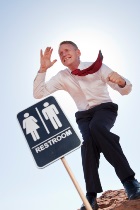 There are some things we just don’t like to talk about. Either they’re embarrassing, uncomfortable, or we feel alone and so suffer in silence.
There are some things we just don’t like to talk about. Either they’re embarrassing, uncomfortable, or we feel alone and so suffer in silence.
Bladder weakness or incontinence can be one of those things, but it has been estimated to affect some 20 million people in the USA alone, making it a very common problem. Health professionals divide the problem into two difference categories – stress incontinence (a slight leakage when you cough, sneeze or play sport) or urge incontinence, when it is hard to make it to the toilet in time.
Both are equally common, with women tending to suffer more often, as the associated pressures on the body of pregnancy and childbirth can contribute to the problem.
In many cases, incontinence is treatable or manageable, so if it is something that affects you, speak to a health professional. It can also be the indicator of another underlying condition (for example prostate problems in men), so it is important to check.
The Royal College of Physicians estimates 8–15% of women aged 45–64 and about 15% of women aged 65 years or over are affected. While the New Zealand Incontinence Association believes bladder problems affect about 40% of men over the age of 45.
One or a combination of excess weight, smoking, diabetes, drugs, hormonal changes, hysterectomy and childbirth may contribute to bladder problems.
Men
Incontinence is less common in men than women with stress incontinence typically occurring after prostate surgery or as a result of nerve damage from a spinal injury. If men experience any of the following symptoms it may indicate enlargement of the prostate.
• Difficulty starting to pass urine
• Taking a long time to start
• Passing urine in stops and start
• Dribbling when trying to stop
• The sensation of not having finished
• Having to get up more than twice a night to pass small amounts
Prostate enlargement affects about 40% of men at the age of 60, rising to 75% by the age of 80. As the prostate enlarges it can interfere with the closure of the base of the bladder, which keeps the urine in place.
No leakage is normal therefore it is important to seek help if you experience symptoms.
Treatment
Treatments differ depending on the type and severity of the symptoms, however studies have shown strengthening the pelvic floor muscles to be the most effective treatment for stress incontinence. Pelvic floor exercises- kegels- target the muscles responsible for stopping the flow of urine. To see results kegels need to be done regularly every day for at least three months. An added benefit of strengthening the pelvic floor is better sex. A strong pelvic floor can strengthen orgasms for women and enhance the ability of men to maintain an erection.
Other treatments include bladder training, dietary alterations, weight loss and medication. Surgery is only required by a small number of women.
A leaky bladder is not something you have to live with. All bladder health problems can be managed and most can be cured. Talk to your doctor or contact the NZ incontinence association www.continence.org.nz for more information.









Join the Discussion
Type out your comment here:
You must be logged in to post a comment.